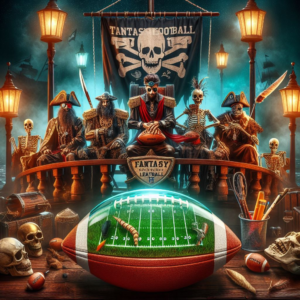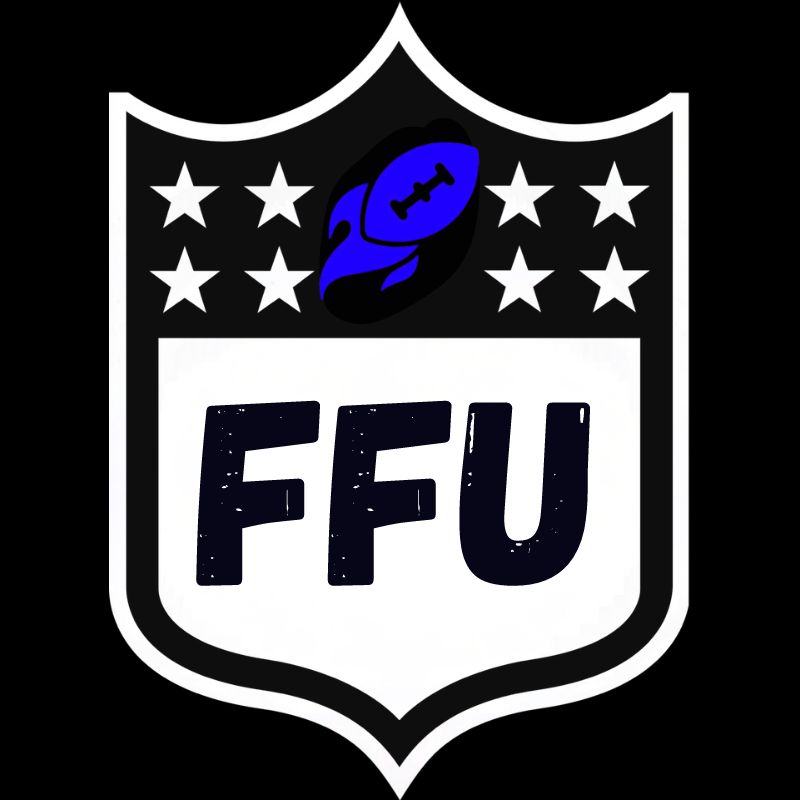For the general public, a standard fantasy football league suffices. If you’re reading this article, you grow weary of normal leagues and choose something new. Crash Course, a Fantasy Football Universe series, delves into unique formats. So, let’s start with Crash Course: Pirate League 101.

How Does it Work?
Arrr! Welcome to ye olde Pirate League. A pirate league starts just like any other redraft league, with a standard draft. The league can feature as many teams as you desire and the draft can be whatever format you prefer, snake, linear, or auction. whatever suits you best. This league is nearly identical to a standard redraft league. You draft, make trades, and set your lineup just like you would normally. The lone difference? A tidy reward for a weekly victory.
How is it different?
As you would imagine in a Pirate League, it’s a cutthroat league. The name of the game is to defeat your opponent so you can pillage and plunder his roster. That’s where the catch comes in. In a normal league, each matchup awards a win or loss to each team, which remains the same in a Pirate League, the difference is that the winning team gets to trade any player in their starting lineup for any player in their opponent’s starting lineup.
You just defeated an opponent with Sam Howell as your starting quarterback while your opponent started Josh Allen, guess what? Now you can send that opponent a trade offer of Howell for Allen and they have to accept it. That’s the kicker—every week matters. Start the season on a 6-game win streak and you can quickly see yourself with an All-Star team. Lose one game because of bye weeks and injuries and your best player can be gone in a flash.
Who does the Draft work?
As stated above, the draft is unchanged. It can be any format, with any amount of teams. If you want to do an 8-team snake draft you can decide to do a 32-team auction and a Pirate League can work with that too. There is absolutely no difference in the draft. The swerve doesn’t happen until the matchups roll around.
A look at the Rosters
Rosters cater to league preference. I favor shorter benches to keep early losers competitive. A winless team, finding startable players on waivers, is likely to stay active. Losing key players with a depleted waiver wire results in a league of inactive managers who quit after a rough start.
Main roster advice depends on the desired competition level. For a casual home league, short rosters ensure everyone fields a startable team. If seeking cutthroat competition, opt for large rosters, emphasizing a strong draft and optimal lineup choices. This league weeds out the weak swiftly, leaving only the boldest and strongest. Remember, every week, half your league gains one stud player, while the other half loses one.
How does the Waiver Wire work?
Reiterating, the waiver wire is open to personal preference. Your choice depends on the pirates’ level of aggression. I favor extensive starting squads and equally deep benches. These leagues often have “AFK” teams by midseason, so why not increase the difficulty for the committed ones? An unfortunate season start might lead you to be forced to walk the plank early.
How the scoring works
Again, scoring is not impacted by the league and can be done in any manner of your choosing. There is no wrong or right answer here, it’s all up to you and your league mates.
The Consensus Strategy
- Draft to Win from Week 1: Avoid stacking quarterbacks with pass-catchers; it guarantees bye-week issues and doubles the impact of player injuries.
- Pay Attention to Bye Weeks: Be wary of when the bye weeks impact your team. Not only do I like to avoid players with early bye weeks but you should be cognizant of bye in general. Getting through your draft only to discover that three of your five starting wide receivers are all on the same bye week. Not only will this leave you scrambling for a replacement but it will kill any opportunity you have to hoard depth.
- Draft For Balance & Depth: As mentioned above, depth is important. Byes and injuries are a natural part of the game and when they come up it can be difficult to find replacements through the waiver wire. So, instead of loading up at one position, try to have a nicely balanced team. This is even more important in auctions where you can spend insane amounts of your FAAB on a small number of players.
- Don’t Over Spend if Auction Draft: Many managers love to load up early in action drafts and go with the “Studs & Duds” approach, but this can quickly leave you in a world of trouble. This is not the format to put all your eggs in one basket. One early injury to your start and you can quickly find yourself starting a backup quarterback as your starter.
My Strategy
- Do Not Stack: Stacking quarterbacks with the pass-catchers on their team has become all the rage in fantasy football, but it’s a terrible strategy in the format. It breaks two rules from the above list. Not only will it guarantee you to have bye week issues, but if one of those players is lost to injury you are getting dinged twice as a result.
- Plan Your Pirating: This can be helpful to look at the next few matchups on your schedule and do your best to project which matchups they may lose before you face them and which players could potentially be pirated off their roster during that time. If I need a tight end and my current opponent has Mark Andrews, but my next three opponents are all streaming the position, I may choose to steal Mark Andrews even if they have better options on their roster.
- Pirate the Waiver Wire: Exploit the waiver wire; maximize your chances by dropping the bottom players on your roster for unusable ones from the waiver wire. The aim is to maximize the damage you inflict on your defeated opponent.
- Set Your Lineup Strategically: If you are a team that cannot afford to lose a stud player to a juggernaut it may be beneficial to punt that week and bench some of your most important players. In my first Pirate League, I faced an opponent who had 7 players playing on Thanksgiving Day, while I had 0. His players crushed me and I was projected to lose by more than 100 points. Knowing that I was fighting a losing battle, I chose to punt and bench all my best players in favor of my backups.

In Closing
This format evokes a love-hate relationship for 90% of managers. A redrafted league with intense dynamics, it’s akin to transitioning poker limits. The swings push you to the brink of madness. One week, you’re on top, feeling invincible; the next, losing your best player and contemplating quitting.
Pirate Leagues demand courage. More painful than losing by 0.2 points is losing like that and then having your best player stolen.
This format suits strangers online, avoiding hurt feelings with friends and family. It’s not your casual beginner league. In it, steal or be stolen from.
Don’t forget to check out the rest of the Crash Course Series.

